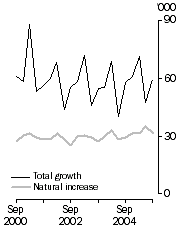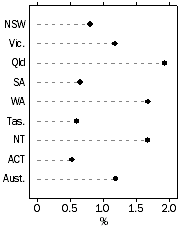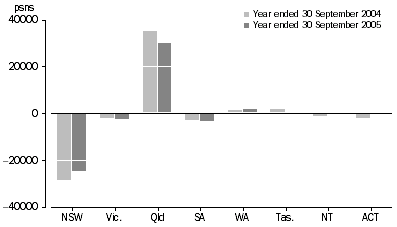SEPTEMBER KEY FIGURES
 | Population at end Sept qtr 2005 | Change over previous year | Change over previous year |  |
| PRELIMINARY DATA | '000 | '000 | % |  |
|  |
| New South Wales | 6 787.8 | 53.9 | 0.8 |  |
| Victoria | 5 037.7 | 58.7 | 1.2 |  |
| Queensland | 3 980.8 | 75.1 | 1.9 |  |
| South Australia | 1 544.7 | 9.9 | 0.6 |  |
| Western Australia | 2 018.7 | 33.2 | 1.7 |  |
| Tasmania | 486.0 | 2.9 | 0.6 |  |
| Northern Territory | 203.7 | 3.4 | 1.7 |  |
| Australian Capital Territory | 325.8 | 1.7 | 0.5 |  |
| Australia(a) | 20 387.9 | 238.8 | 1.2 |  |
|  |
| (a) Includes Other Territories comprising Jervis Bay Territory, Christmas Island and the Cocos (Keeling) Islands. |
Population growth, Quarterly

| Population growth rate, Year ended current quarter

|
SEPTEMBER KEY POINTS
ESTIMATED RESIDENT POPULATION
- The preliminary estimated resident population (ERP) of Australia at 30 September 2005 was 20,387,900 persons, an increase of 238,800 persons (1.2%) since 30 September 2004 and 59,300 persons (0.3%) since 30 June 2005.
- Preliminary natural increase during the September quarter 2005 was 31,200 persons, an increase of 7% (or 2,000 persons) on the figure recorded for the September quarter 2004 (29,100).
- Preliminary net overseas migration during the September quarter 2005 was 28,100 persons, a decrease of 1.2% (or 340 persons) on the number recorded in the September quarter 2004.
POPULATION GROWTH RATES
- The Australian population grew 0.3% during the September quarter 2005 and 1.2% during the 12 months ended 30 September 2005.
- Natural increase and net overseas migration contributed 52.6% and 47.4% respectively to Australia's total population growth for the September quarter 2005.
- During the September quarter 2005 all states and territories experienced positive population growth.
- Population gains were also recorded for all states and territories for the 12 months ended 30 September 2005. Queensland recorded the largest percentage gain (1.9% or 75,100 persons) and the Australian Capital Territory recorded the lowest (0.5% or 1,700 persons).
NOTES
FORTHCOMING ISSUES
| ISSUE (QUARTER) | Release Date |
| December 2005 | 2 June 2006 |
| March 2006 | 21 September 2006 |
| June 2006 | 7 December 2006 |
| September 2006 | 22 March 2007 |
| December 2006 | 5 June 2007 |
INTRODUCTION
Estimated resident population (ERP) data in this publication are based on the 2001 Census of Population and Housing. Exceptions are tables 17, 18 and 19 (excluding 2001 estimates), which are based on the 1996 Census of Population and Housing.
CHANGES IN THIS ISSUE
There is a change of release date for the December quarter 2005 issue. The release date has now been brought forward to 2 June 2006 from 5 June 2006.
Preliminary 2005 population estimates for Capital City Statistical Divisions and selected Statistical Districts have been included and are based on the 2005 Australian Standard Geographical Classification (cat. no. 1216.0). See Table 5 in this issue.
ERP DATA STATUS
At any point in time this publication contains final, revised and preliminary ERP data. The status of the ERP data included in this issue is as follows:
- Final - All ERP data up to and including June quarter 2001
- Revised - ERP data from September quarter 2001 to June quarter 2004, inclusive
- Preliminary - ERP data from September quarter 2004 to September quarter 2005, inclusive.
DATA NOT YET AVAILABLE
Progress is continuing with the review of annual household estimates methodology. See Tables 17, 18 and 19. A new methodology has been proposed and is currently being assessed. Implementation details will be made available once this assessment is complete.
INQUIRIES
For further information about these and related statistics, contact the National Information and Referral Service on 1300 135 070 or Cassandra Eaves on Canberra (02) 6252 5640.
MAIN FEATURES
INTRODUCTION
The preliminary estimated resident population (ERP) of Australia at 30 September 2005 was 20,387,900 persons, an increase of 238,800 (1.2%) since 30 September 2004 and 59,300 (0.3%) since 30 June 2005.
COMPONENTS OF AUSTRALIA'S POPULATION CHANGE
The growth of Australia's population has two components: natural increase (the number of births minus the number of deaths) and net overseas migration (net permanent and long-term movement).
Natural increase
Preliminary natural increase for the September quarter 2005 was 31,200 persons, contributing 52.6% to Australia's quarterly population growth. The number of births registered for the September quarter 2005 (67,500) remained approximately the same as the June quarter 2005, while the number of deaths (36,300) increased by 11.9% over the same period.
Natural increase for the year ended 30 September 2005 was 129,100 persons. During this period, births contributed 259,400 babies to the population and deaths removed 130,300 people from the population. This represents an increase of 7% (or 8,300 persons) on the natural increase recorded for the year ended 30 September 2004.
Due to the collection and estimation method applied to produce these statistics, users should exercise caution when analysing and interpreting the most recent annual and quarterly births estimates, particularly when making time series comparisons. The Australian Bureau of Statistics (ABS) recommends users refer to Births, Australia (cat. no. 3301.0) for analysis of fertility trends over time. See paragraph 7 of the Explanatory Notes for more detail.
Net overseas migration
For the September quarter 2005 net overseas migration (28,100 persons) contributed 47.4% to Australia's quarterly population growth. This was a decrease of 1.2% (or 340 persons) on the number recorded for the September quarter 2004.
The ABS applies a number of adjustments to the overseas arrivals and departures data used to produce estimates of net overseas migration (NOM). These mainly comprise adjustments designed to reflect differences between stated travel intentions and actual travel behaviour, but (in the case of revised NOM estimates) also include adjustments to transform numbers of overseas movements into numbers of travellers. These are collectively referred to as 'migration adjustments'. For more information see the Technical Note - Measuring Net Overseas Migration.
STATES AND TERRITORIES
Population
Populations for the states and territories at 30 September 2005 were as follows: New South Wales 6,787, 800, Victoria 5,037,700, Queensland 3,980,800, South Australia 1,544,700, Western Australia 2,018,700, Tasmania 486,000, Northern Territory 203,700 and the Australian Capital Territory 325,800.
Growth rates
All states and territories recorded positive population growth during the September quarter 2005. The Northern Territory recorded the fastest growth rate (0.5%), followed by Western Australia and Queensland (0.4%), Victoria (0.3%), and New South Wales, the Australian Capital Territory, South Australia and Tasmania (0.2%).
Similarly, all states and territories recorded positive growth for the year ended 30 September 2005. The highest annual growth rate was recorded by Queensland (1.9%) and the lowest by the Australian Capital Territory (0.5%).
Interstate migration
During the September quarter 2005, Queensland, Western Australia, the Northern Territory, Tasmania and the Australian Capital Territory recorded net interstate migration gains, while New South Wales, Victoria and South Australia recorded net losses.
Interstate migration was the largest contributor to Queensland's annual population growth (40.0%) with a gain of 30,000 persons for the year ended 30 September 2005. Net gains were also recorded for Western Australia (2,000 persons), the Northern Territory (210 persons) and Tasmania (70 persons) and net losses recorded for New South Wales (-24,900 persons), South Australia (-3,700 persons), Victoria (-2,900) and the Australian Capital Territory (-770).
NET INTERSTATE MIGRATION, States and territories

 Print Page
Print Page
 Print All
Print All